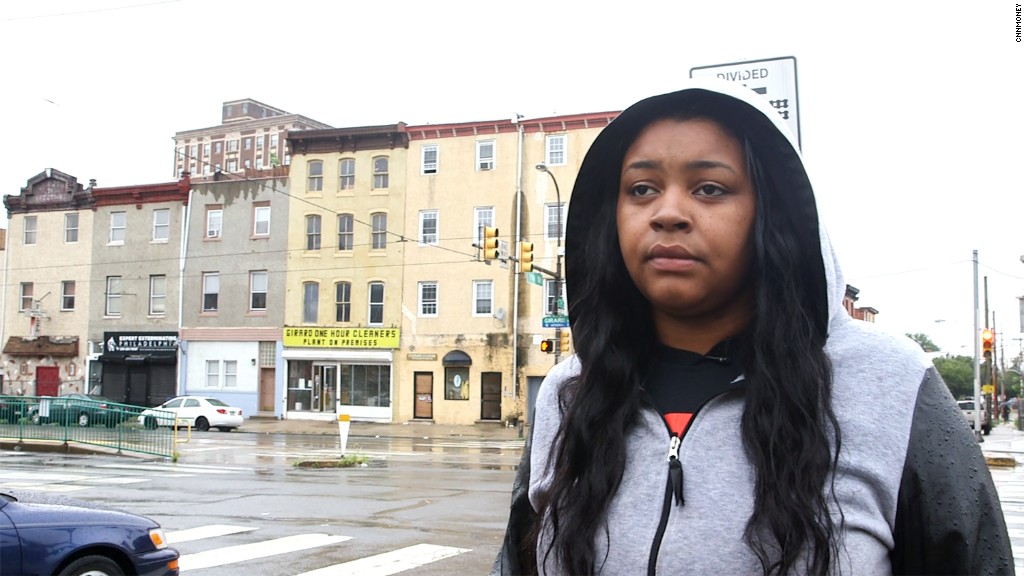
Americans didn't get a raise last year. In fact, they haven't gotten one in years.
The typical American family income was $53,657 in 2014, barely changed from $54,462 a year earlier, the U.S. Census Bureau reported Wednesday.
What's worse ... it's far below the peak set in 1999. That's a major reason why so many Americans are still gloomy about the economy six years into the recovery.
This was the third year in a row that median household incomes stagnated, following two years of declines. Whites saw their incomes decline 1.7%, while blacks, Hispanics and Asians saw no significant difference.
"Clearly, the improving economy and falling unemployment have yet to adequately lift the living standards of middle- and low-incomes," Jared Bernstein, senior fellow at the Center on Budget and Policy Priorities, wrote on his blog.
Median income remains lower than it was in 2007, Census said. Precise comparisons, however, are now difficult because Census changed its methodology last year so it could provide a more detailed look at the sources of Americans' income.
The holding pattern in wages comes despite the fact that millions more Americans are working. Some 1.2 million more men and 1.6 million more women are working full-time, year-round, respectively.
The earnings of women who work full time were essentially the same as they were in 2007, while men's earnings were 2.2% lower.
Wage stagnation is a central focus of the 2016 presidential election. The Democratic candidates want to raise the minimum wage and widen the safety net, while Republicans want to spur job creation by lowering taxes and shedding regulations.
Poverty remains high
Meanwhile, the nation's poverty rate also held steady at 14.8% last year. Some 46.7 million Americans were in poverty, compared to 46.3 million in 2013.
In 2014, the weighted average poverty threshold for a family of four was $24,230.
The poverty rate remained flat after dropping in 2013, which was the first decline since it shot up during the Great Recession. A lot of the decrease had come from people finding full-time work -- and thus earning more money.
Some 26.2% of blacks were in poverty in 2014 and 23.6% of Hispanics, essentially unchanged from a year earlier. For whites, the rate was 10.1%.
More than 1 in 5 American children were in poverty, essentially unchanged from a year earlier.
That the poverty rate remains so elevated years after the recession ended is disappointing, said Robert Doar, fellow in poverty studies at the American Enterprise Institute, a conservative think tank.
"The recovery is anemic and slower than the typical recovery," said Doar.
The Census Bureau also released an alternate poverty measure that takes into account various government benefits and expenses not captured by the official poverty rate. The so-called Supplemental Poverty Measure showed 15.3% of Americans were in poverty last year, not statistically different than a year earlier.
Work-related costs such as transportation and child care, as well as medical and tax expenses drove more people into poverty, the report showed. These costs outweighed the benefit of non-cash public assistance, such as food stamps, housing vouchers and refundable tax credits, which have helped lift many Americans out of poverty in the past.
This alternate measure shows the importance of refundable tax credits -- including the Earned Income Tax Credit and the Child Tax Credit, which go to low- and moderate-income workers, said Jane Waldfogel, a Columbia University professor and author of forthcoming book, Too Many Children Left Behind.
These credits helped to lower children's poverty rate to 16.7% under the alternate measure.
Millions more have health coverage
The Census Bureau also reported that the uninsured rate fell to 10.4% in 2014, the first year people could sign up for coverage on the Obamacare exchange or through Medicaid expansion in many states. That's down from 13.3% the year before. Nearly 9 million more people had health coverage in 2014 than a year earlier.
But more recent government data found that the uninsured rate fell to 9.2% in the first quarter of this year, which marks the first time in decades the uninsured rate has dropped below 10%. Some 29 million people lacked coverage, down 7 million from a year earlier, the report found.
Not surprisingly, Wednesday's Census data shows the largest increases in coverage came in Medicaid and direct-purchase plans, which includes those bought on the Obamacare exchange.
Hispanics continued to have the highest uninsured rate, at 19.9%, followed by blacks at 11.8%. Both dropped by more than 4 percentage points from 2013. The Obama administration has focused on signing up Hispanics and blacks for Medicaid or Obamacare plans, though advocacy groups have been somewhat disappointed with the results.
Non-Hispanic whites' uninsured rate was 7.6%.


